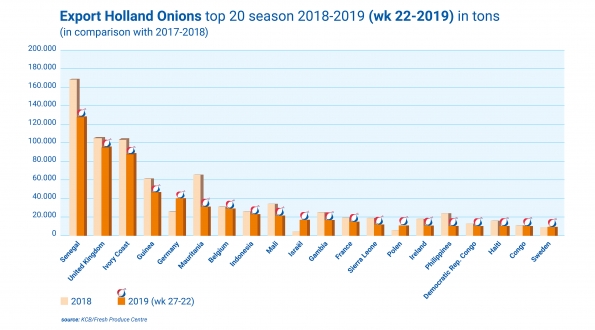first decline in export since the turn of the millennium
The extremely dry summer of 2018 has left its mark. After years of significant growth in the export of onions, the dramatically low yields per hectare had a drastic impact on the export volume this year. Through one stroke of nature the Holland Onion harvest of 2018 truly became a limited edition. Never before have people paid so much for a Holland Onion as in this past season and with that the joint revenue of the sector will no doubt break a record. Some Dutch farmers have done good business, while others that had to plough under their poor harvest were left empty-handed.
The limited supply and the high prices had a downside. Around the world the interest in our Holland Onion decreased and loyal customers had to go looking for alternatives. It will most likely result in the export volume stalling at more than 800.000 (metric) tons against 1,2 million (metric) tons in the previous export season. So there is plenty of work to be done for the Holland Onion Association in the coming seasons to once again prove ourselves a reliable supplier of quality onions. There is a challenge ahead that we need to face as a chain, or as the Dutch would say: ‘we have to keep our feet on the pedals in order to be able to stay with the front-runners!’
Uireka
Our main objective remains to further enhance the quality of the Holland Onion. It’s not all about yields. We must develop a healthy and sustainable foundation for our crops. In terms of rotation, varieties and now also irrigation. Important focal points that are a substantial part of the chain-wide quality research Uireka (https:/www.uireka.nl) in the coming years. The first results of the trajectories plotted in 2017 are promising and require further research and innovation. We already know more for example regarding the influence of nitrogen and potassium on the firmness of our Holland Onion. We can detect latent neck rot with a jointly developed genetic test. And our first research results indicate organic residuals do not carry pathogens with them onto the land. All sound and promising Uireka research results that you can receive automatically in your email inbox by subscribing at https://uireka.nl/#newsbrief.
Top 20 of 2018/2019
Not much as has changed within the top 20 - apart from the significantly lower export volumes. Senegal remains at the top of the list, but Great Britain is closing in on them, replacing the Ivory Coast as the number two. A notable newcomer, coming from the 36th position and moving up to the 10th place, is Israel with more than 17.000 (metric) tons, a fourfold increase compared to the previous season.
It is also worth pointing out that the export to neighboring European countries has likewise risen steeply. It is clear that drought has affected all of North-Western Europe. The export to the Czech Republic has grown substantially and even doubled to more than 6.500 (metric) tons. The same is true for countries such as Hungary, Norway and Greece, but also Denmark and Slovenia showed a considerable growth. And we even got to welcome two newcomers: Azerbaijan and Albania. The importance of sufficient fresh water for agriculture is highlighted in these statistics. It is no coincidence that this subject is a focal point in the new research program Uireka 2.0.
